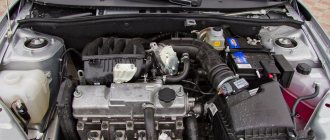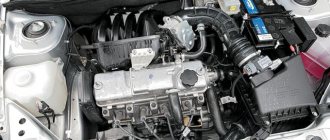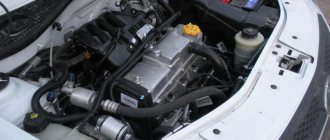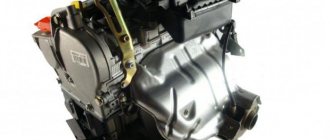Many people know that the modern market is very saturated with various kinds of goods. It varies not only in quality, but also in purpose. In particular, we are talking about the automotive world, which is developing very quickly. Just a few decades ago, no one could have imagined that modern man would travel in a vehicle without manpower. Currently, the VAZ 2110 engine has become very popular, which is not surprising.
The fact is that it is very simple and does not require much attention during maintenance. Not all modern engines can boast of such properties. In addition, you do not need a huge financial investment if it breaks down, which is good news. In this article we will talk about the VAZ 2110 engine 8 valve injector, used in the modern automotive industry.
Specifications
Download .xls file
xls
Download picture
Send by email
| PARAMETER | MEANING |
| Type | Four-stroke, gasoline |
| Number of cylinders and their location | Four cylinders, in-line arrangement |
| Total unit volume | 1.5 liters |
| Engine power | 73 horsepower |
| Compression ratio | 9.9 |
| Minimum power when rotating 5600 rpm | 53 Kilowatts or 72 horsepower |
| Torque | 103 Newtons per meter or 10 kilograms per meter |
| Power unit weight | 126 kilograms |
| Fuel used | AI – 92, AI – 95 |
| Ignition system | Contactless |
| How cylinders work | 1 – 3 – 4 – 2 |
This motor is installed on the following cars: VAZ 2110, VAZ 21083.
Main engine components
No significant differences may be detected upon a cursory examination. Both carburetor and injection systems do not affect the basic design of the engine. But it's worth taking a closer look at the little things. For example, take a look at the VAZ-2110 injector thermostat (8 valves). What immediately catches your eye is that it can be taken apart! Exactly! Engineers in Europe sit and think about how to reduce the life of a car, while ours at the same time carry out real improvements that are for the benefit of the consumer. It is clear that it is not the housing that breaks in the thermostat, but the insides - the temperature-sensitive element or valve. Therefore, why produce millions of cases? It will be much more profitable to make one for the car, and if the thermostat breaks down, change only the insides.
But these are not all the advantages of domestic engines. Please note that in the USA and Europe all cars are the same, sometimes there is no point in repairing it, it’s easier to throw it away and buy a new one. The reason is partly in the engine. For example, AvtoVAZ is almost the only plant that continues to install internal combustion engine blocks made of cast iron on its products! In all developed countries, aluminum alloys have long been used for this purpose! The service life of the engines suffers, but most importantly, there is no way to repair it, since it cannot be bored or relined. And this is much cheaper than buying a new engine or car. Maybe a wealthy burgher can afford this, but in our country a car is still a luxury for many people.
Design
I would like to note that this power unit was installed on many cars. It does not require much attention during maintenance and costs during repairs.
- It is based on a simple four-cylinder 2110 engine equipped with a direct injection system. The latter allows fuel to be injected into each cylinder of the engine to produce maximum power. The material is quite simple, high-strength cast iron with the addition of some elements. This combination allows for a very durable structure that can withstand shock and temperature changes.
- Cooling is carried out throughout the unit, evenly. This move completely eliminates overheating of the power unit and its failure.
- As for the cooling jacket, it is slightly open towards the cylinder head and cylinders. The lower part of the block is equipped with crankshaft bearing supports, which have special fastenings.
- The crankshaft itself is made of high quality cast iron. This was not done by chance, because only cast iron is able to withstand colossal temperatures and loads. No other material can produce such results. All connecting rod bearings are lubricated through oil valves that are drilled along the entire length of the crankshaft. This is very convenient and practical, especially in the summer.
- The power unit also has a vibration reduction system. It consists of several dozen counterweights located on the crankshaft. Due to this, the 2110 motor will not vibrate while moving.
- In front of the crankshaft you can see the oil pump with a timing belt pulley. At the rear there is a flywheel made of high-quality cast iron.
- All connecting rods are made of high-quality steel using forging. A small feature is the caps on the heads. There is a liner in the lower part, and a pressed-in bushing in the upper part.
- All pistons are equipped with three rings: two for compression, one for oil control. As for the material of the pistons, it is simple aluminum.
- On the bottom, the designers made special recesses for the combustion chamber. On top of all this is installed a cylinder head made of an alloy of steel and aluminum. Due to this, the 2110 motor is very durable and practical.
- At the bottom of the cylinder block you can find special channels designed for coolant circulation.
- A small feature of the VAZ 2110 engine is that the camshaft is located in the upper part of the power unit on supports. To reduce wear of parts, they are subjected to heat treatment. Thanks to this, the parts will not lose their properties during long-term operation.
- I would also like to note that the 8-valve engine has two valves per cylinder: intake and exhaust. They allow the fuel mixture to enter and exit the cylinder, thereby completing operating cycles. In addition, they are equipped with special springs. It is very convenient and practical. In addition, the engine from the VAZ 2110 receives good power and torque.
- The guide bushings and all valves are completely pressed into the cylinder head.
- The camshaft is driven by a simple timing belt from the crankshaft.
- I would also like to say something about the VAZ 2110 engine cooling system. The fact is that there is a fairly powerful electric fan installed here that turns on at a temperature of 115 degrees. It turns off when the power unit cools to 95 degrees.
- The power supply system is equipped with the following components:
- Fuel tank;
- Fuel lift pump;
- Air filter;
- Fuel lines;
- The carburetor itself.
It is worth noting that the fuel pump is located on the cylinder head itself and is driven by a pusher from the eccentric to the camshaft. All electronics of this type of car are focused on a simple controller. In simple words, an electronic control unit.
From the technical data sheet it is clear that the lubrication system has a combined system:
- By spraying;
- Under high pressure.
This system helps protect the power unit and mechanisms from damage and poor lubrication. All mechanisms will receive a sufficient amount of oil, which is very good. You don't have to worry about this. The VAZ 2110 engine with 16 valves is characterized by good durability and ease of maintenance.
Costs for Lada 110
Insurance and taxes on the Lada 110 are unlikely to ruin you, because even the most powerful engine, the “ten,” develops less than 100 hp. An MTPL policy for an experienced driver with a long accident-free record will cost 4,348 rubles in Moscow in 2022, and the transport tax on a 93 hp engine will be 1,116 rubles.
Maintenance and repairs of the “tenth family” are also budget-friendly. As you can see, even the entire steering rack can be replaced for only 3800 rubles (prices of the Emex online spare parts store, 2020).
Modifications
The standard VAZ 2110 contains new developments and some features.
The first car was completely carburetor and 8 valve. This system had a volume of 1.5 liters and made it possible to develop about 70 horsepower.
This potential was enough to get real pleasure from movement. As for the maximum speed, it varies within 160 kilometers per hour.
After the carburetor engine, the designers decided to make an injector (already 16 valve). Essentially, these are the same 1.5 liters of volume, but with slightly increased engine power to 79 horsepower. This move made it possible to improve dynamism and increase maximum speed.
A small feature is that the system has a 16 valve VAZ engine. This is very unusual for cars of this class.
Until the 90s, the vehicle had a rather sparse interior and exterior. The designers made the car as a means of transportation, not a luxury. Only after the 90s were customers able to get a spacious trunk, comfortable seats, an adjustable steering wheel, air conditioning, and so on. Over the entire production period of the VAZ 2110, a huge number of modifications of its engine were developed: both an 8-valve carburetor and a 16-valve injector.
Interior features
The interior space of the tenth family is no different in design features. Everything here is simple and accessible: a dashboard with a large speedometer, a four-spoke (in early models) or two-spoke (in later models) wheel. For the convenience of the driver, the center console is turned towards him, but because of this decision, the front passenger's left knee rests against it.
Torpedo Lada 110 (2110) 1995–2007
In the top ten, they abandoned the “stool seating”: now the driver could sit behind the wheel with his legs extended, and not with them bent, as was the case before. The dashboard itself was made of soft plastic, which did not creak in the cold and was pleasant to the touch.
The interior is cramped: while the front passenger can still put up with the inclined central panel, the rear passengers will have to be content with narrow legroom, a highly protruding tunnel in the floor and a low ceiling, the existence of which passengers learn about at the first speed bump.
Interior Lada 110 (2110) 1995–2007
The trunk easily fits four wheels or a large stroller. Its volume is 450 liters. However, it is not possible to increase the compartment due to the non-folding rear row of seats.
Model 2110 at the time of its release became the first model of the VAZ family to acquire an adjustable steering column.
Service
This section includes changing the oil and adjusting the valves (8 and 16 valve engines).
Experts recommend changing the oil every 15 thousand kilometers. If you do not comply with these requirements, the power unit will quickly fail. The fact is that oil loses its properties over time and accumulates many harmful substances. Without changing the oil and flushing the engine, the car will not last long. The VAZ 2110 engine mounts are also being replaced.
Procedure during draining:
- Unscrew the plug located under the bottom of the power unit. In this case, you can use a special key;
- Carefully drain the used oil so that it does not get on your skin. If you are not careful, you can get a very serious burn to the skin as the oil is very hot;
- Next, you can wipe the bottom of the power unit to get rid of any remaining oil;
- Screw the plug back;
- We unscrew the oil filter, which is located under the hood of the vehicle. To make your work easier, you can use a set of keys. We also replace the engine mount;
- Coat all filter gaskets with a thin layer of oil. This is necessary so that the filter can easily fit into the fitting place. The force applied should be monitored very carefully. If you exaggerate with force, you will strip the thread.
Actions during pouring:
- Carefully unscrew the filler cap;
- We take new oil in our hands and begin to pour it into the neck in the amount of three liters. In this case, you need to monitor the level so as not to overfill. Otherwise, the oil will end up in unnecessary areas of the engine;
- Next, you can start the power unit and wait a few minutes until the system warms up and the oil goes through several circles. Only after 20 minutes can you check the oil level. If it is not enough, then feel free to add more. In other cases, the process is completed, you can screw on the cover and put in the replaced engine mount;
- We also check the dashboard. The Check Engine light should not be on.
ADJUSTMENT OF VALVES
This process is the most complex and quite interesting. The performance of the power unit and its stability will depend on the correctness of the actions.
If you want to tune the VAZ 2110 engine, then adjusting the valves can be classified as some kind of tuning.
The adjustment is carried out using the device:
- Open the valve mechanism cover and completely remove the timing belt cover;
- We install a device that will allow you to easily carry out all the actions;
- We put the necessary marks on both the crankshaft and the camshaft. They are necessary for proper adjustment. You should also check the timing belt. It should be taut, not hanging;
- Checking the gap;
- Next, unscrew the washer and replace it with a new one according to the formula:
Н = В+(А–С), mm,
- where A is the measured gap;
- B – thickness of the removed washer;
- C – nominal gap;
- N – thickness of the new washer.
Advantages and disadvantages
Pros of the car
- Available service;
- Availability of spare parts;
- Possibility of repair “in the garage”;
- Front-wheel drive;
- 16-valve injection engine;
- Improved security system;
- Low fuel consumption;
- Suspension adapted to poor-quality road surfaces;
- There is a hydraulic power steering wheel;
- The steering column can be adjusted;
- Air conditioning can be installed;
- Improved front panel.
Cons of the car
- Corrosion of metal;
- Small resource of some spare parts;
- Build quality;
- Unbalanced operation of the stove;
- Low sound insulation of the cabin;
- Constant monitoring of the timing belt;
- Equipment.
- There is little free space inside the car;
- It will be uncomfortable for three adult passengers to sit in the back.
Tuning
And in conclusion, I would like to say about tuning the VAZ 2110 engine.
In the VAZ 2110, engine tuning is very easy to do. To do this, you only need a tool and a room. This process can be done not only in a specialized workshop, but also in your garage.
Tuning a VAZ 2110 engine requires only a set of tools and patience:
- The first step is to simply replace the camshaft with a better one. Due to this, power will increase and engine performance will improve.
- You can also install a new crankshaft to increase the volume of the unit. If this is not done, then further tuning of the VAZ 2110 engine will be in vain.
- The installation of a compressor is quite simple. This unit allows you to increase power and get good torque.
- It is worth noting that tuning the VAZ 2110 engine can be done by anyone. This does not require special experience or skills. It is enough to know the structure of the car and have locksmith skills. Experts recommend installing a high-quality stock piston so that it can withstand about 0.5 bar.
Let's sum it up
An important advantage of the “ten” is the highest liquidity - over almost 20 years of production, so many of them were produced that now the choice on the secondary market is simply huge. But since the body of the Lada 110 was made of frankly lousy metal, it is not durable . As a result, most cars, without regular anticorrosion treatment, literally rot through and through by the age of 10-15 years. At the same time, the engines and transmissions of the “tenth family” are quite durable, durable and easy to repair, so these “rusty troughs” are still running on our roads.
In 2022, a live Lada 110 can be purchased for 120-150 thousand rubles , and if you try, you can find a good copy even for 100-110. Buying cheaper is not advisable; most likely, the car will have a rotten body, a tired engine, transmission and chassis. The best option , in my opinion, is a modification with a “124” engine, power steering and air conditioning , in any type of body, the main thing is that it has factory paint, and without serious pockets of corrosion.
The list of the main alternatives to the “tens”, for this money, looks like this:
- Lada Samara
- Lada Kalina
- Lada Priora
- Daewoo Nexia
- Chevrolet Lanos
To summarize, let's once again list the main advantages and disadvantages of the “tenth family”
pros
- High liquidity
- Low cost of repairs
- Cheap and affordable spare parts and consumables
- Cheap insurance and tax
- Reliable and economical motors
Minuses
- The body is rapidly rusting
- Low quality parts
- Poor sound insulation
In addition to objective factors, the Lada 110 also has a good image . There is a strong image of a fast, comfortable, strong and reliable car around the “tenth family”, which is why people buy them very willingly. The 2110 sedan is perfect for those who need to look respectable. Station wagon 2111 is ideal for a traveler or family man. And 5-door and especially 3-door hatchbacks will be a good choice for stylish, young, energetic drivers. “Tens” are 100% masculine cars that enjoy a certain respect.
That's all, friends! If you have anything to add, I will be grateful for your comments under the article. Good luck with your car shopping! And for dessert, a short video about the tenth family.
© Kak-Kupit-Auto.ru
Links: zr.ru
The principle of operation of an injection engine
So, after we have figured out the main components of an injection engine, let's see how it works. After the starter cranks the crankshaft, the DPKV tells the control unit which cylinder is in which position. In turn, the phase sensor reported the clock cycles. The control unit took this information into account and opened the injector in the cylinder in which the intake stroke begins. But he opened it for a reason, but for a strictly defined period of time, which, according to the tables, corresponds to the readings of the mass air flow sensor or DBP. This is how the working mixture was formed.
Video: how a gasoline injection internal combustion engine works
After the intake stroke has ended here, compression begins, at which time intake occurs in the other cylinder. Here the piston reaches top dead center, as indicated by the DPKV and DF, respectively, it is time to apply voltage to the ignition module, to the desired cylinder. To do this, the control unit contains two transistors, which take over two cylinders each.
Then, when the explosion occurs, the ECU looks at the readings of the knock sensor and adjusts the ignition timing for the next cylinder along the stroke. But that is not all. After this, when the gases reach the oxygen sensor, the control unit adjusts the composition of the mixture, namely, the opening time of the injector, which allows for the most efficient use of fuel and its combustion. If the ECU detects a lack of oxygen, but the throttle valve remains open, the idle air control valve opens slightly.
Engine warm-up and engine temperature sensor
This point is worth considering separately; let’s just say this is a small clarification. So, the engine warm-up mode is in no way connected with the readings of some sensors, that is, nothing depends on them. In particular, these are mass air flow sensor and air pressure sensor, as well as a knock sensor. The block, as already mentioned, contains certain tables, there are a lot of them, millions. So, during the warm-up mode, the ECU works strictly according to these tables and nothing else. This means that if the air to fuel ratio is written into it as 14.1:1, then it will be so. This figure is the generally accepted standard for operating temperature. So, until the engine temperature reaches the one specified in the firmware of the control unit, the warm-up mode will not turn off. Afterwards the ECU starts working based on the sensors.
Which is better, an injection or carburetor engine?
This issue is quite controversial; each point of view has many opponents and supporters, both among ordinary drivers and among specialists who fully understand the principle of operation of an injection engine. So, the carburetor engine is distinguished by simplicity and transparency of operation. That is, if the mechanic adjusted the idle speed, then it remained that way.
As for the injection engine, it all comes down to timely maintenance, as well as the quality of the parts used.
>
Injection engine sensors
All elements can be divided into actuators and sensors. First, we'll look at sensors.
Mass air flow sensor (MAF)
This element is installed in front of the air filter, right at the inlet. Its operation is based on the principle of difference in readings. So, electricity passes through two platinum filaments. Their resistance changes depending on the temperature. One of the threads is reliably hidden from the air flow, which makes its resistance unchanged. The second one is cooled by the flow, and based on the difference in values, according to the same tables mentioned above, the ECU calculates the amount of air.
Engine absolute pressure and temperature sensor (DBP)
It is used either as an alternative or in conjunction with the above for higher reading accuracy. In short, it has two chambers, one of which is sealed and has an absolute vacuum inside. The second chamber is connected to the intake manifold, where a vacuum is created during the intake stroke. Between these cameras there is a diaphragm, as well as piezoelectric elements. They generate tension when the diaphragm moves. The signal then goes to the ECU.











